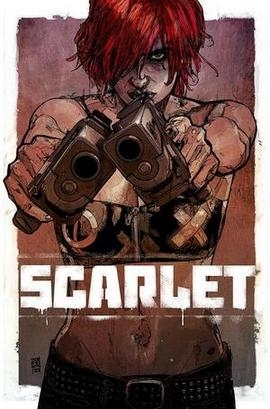Scarlet #1
By Zak Edwards
July 13, 2010 - 13:43
Icon
Writer(s): Brian Michael Bendis
Penciller(s): Alex Maleev
Inker(s): Alex Maleev
Colourist(s): Alex Maleev
Letterer(s): Chris Eliopoulos
Cover Artist(s): Alex Maleev, variants by David Lafuente and Mike Dedato
$3.95 US
I feel like sometimes I only like Brian Michael Bendis for about three titles, which is saying something considering Amazon comes up with over three hundred and fifty hits. Admittedly, a lot of those are reprints and multiple volumes of the same series, but that is still a lot of work for a single person. He is extremely prolific, pumping out a ton of Marvel books each month, most of which, let’s face it, are pretty good for what they are. As much fun as it is to harass Marvel for their books, the choice to keep Bendis happy and working is one that has paid off and continues to do so. But personally, I mostly follow Bendis for his really, really good dialogue and his awesome noir, which has been lacking lately. It makes me feel like I jump onto new Bendis projects just to see if Alias will happen again and, of course, it hasn’t; even when I did get my hopes up with Spider-Woman, which turned into a big disappointment. This love of Alias (go get it, read it, you’re welcome) was right at the forefront of this issue for me and I have to say, Bendis may be onto something here, but he’s made a lot of promises.
 |
| Guns pointed at the camera, or reader, accentuates the fourth wall breaking of the issue. |
Alex Maleev, Bendis’ longtime cohort, reunites with Bendis after the less than stellar Spider-Woman. But this book contains some of the minor moments of experiment the script does, mostly through a series of snapshots giving the main character an origin of sorts. The three page sequence consists of a bunch of pictures with various captions underneath, from “Birth,” following through a variety of major moments like boyfriends, sexual experience, and achievement. While not incredibly different, the break in form, coupled with the scripts fourth wall nature, is a strong declaration. As for the art in general, Maleev’s style is as strong and powerful as ever, and this book does not disappoint. Maleev’s gritty, fairly realistic style, coupled with a darker colour scheme coupled with splashes of stronger colours, makes this book look exactly like it should. His avoidance of creating particularly beautiful or disproportionate bodies helps as well, keeping a focus on the ‘real world’ setting Bendis is striving for. The city itself is firmly Portland as well, having fairly famous landmarks show up occasionally. Overall, Bendis and Maleev’s continuing professional relationship is over the Spider-Woman mix-up and is on to something much better and bolder.
Grade: A This a very strong debut, I’m in.
